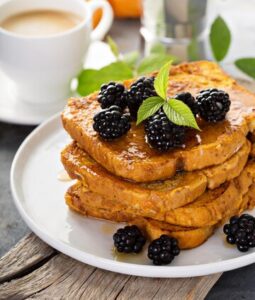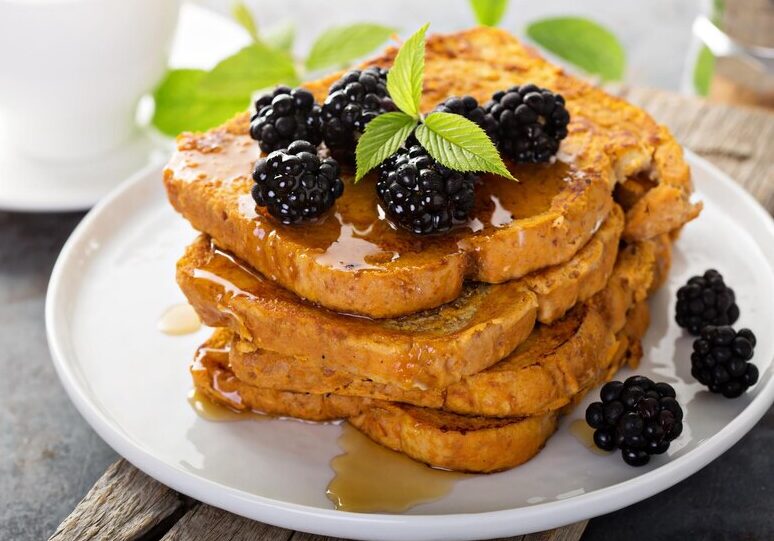French toast is a breakfast classic that, when done right, is a delightful combination of crispy edges and a soft, custardy interior. But what’s the trick to making it just right? Let’s dive into the secrets of making the perfect french toast.
Choosing the Right Bread for a perfect french toast .
The foundation of great French toast lies in choosing the right bread. Not all breads are equal, and selecting the ideal one is crucial for achieving the desired texture and flavor.
- Ideal Bread Types:
- Brioche: Rich and buttery, perfect for a decadent French toast.
- Challah: Slightly sweet and soft, creating a balanced flavor profile.
- Sourdough: Offers a tangy flavor that adds complexity to the dish. For more details on using sourdough, check out How to Make the Perfect Sourdough French Toast.
Using slightly stale bread is ideal because it absorbs the egg mixture without becoming too soggy, resulting in a perfectly crispy exterior and soft interior. To explore more about the best bread options, visit What is the Best Bread for French Toast?.
The Perfect Egg-to-Milk Ratio .
The egg-to-milk ratio in your batter is a key factor in achieving the perfect texture. An overly milk-heavy batter can make the toast soggy, while too much egg can result in a dry outcome.
- Standard Ratio:
- A common ratio is 1 egg to ¼ cup of milk, which provides a balanced moisture level.
- Adjusting for Different Breads:
- Denser breads like sourdough may require a slightly higher milk content. If you’re curious about how sourdough performs in French toast, Does Sourdough Bread Make Nice Toast? offers some valuable insights.
Seasoning the Batter .
Seasoning is where you can add a personal touch to your French toast.
- Essential Spices:
- Cinnamon and nutmeg are classic choices that add warmth and depth.
- Vanilla extract enhances the flavor and adds a hint of sweetness.
Consider adding a tablespoon of sugar or maple syrup to the batter for extra sweetness, and zests like lemon or orange for a refreshing twist.
Soaking Techniques .
The soaking process is where many French toast attempts go awry. Over-soaking can result in a mushy texture, while under-soaking leaves the bread dry.
- Optimal Soaking Time:
- For most breads, soaking for about 20-30 seconds per side is sufficient.
- Even Coating:
- Using a shallow dish or baking sheet can help you coat the bread evenly. Gently press the bread down to ensure it absorbs the batter uniformly.
Cooking Methods for a perfect french toast.
Cooking French toast requires a careful balance of heat and fat. The right pan and cooking temperature can make all the difference.
- Choosing the Right Pan:
- A non-stick pan is ideal for easy flipping and even cooking.
- Heat Management:
- Cook on medium heat to ensure the toast cooks evenly without burning.
- Butter vs. Oil:
- While butter adds flavor, it has a lower smoke point than oils. A combination of butter and oil can give you the best of both worlds—rich flavor with less risk of burning.
Enhancing the Texture .
The texture of French toast is what sets apart the good from the great.
- Creating a Crispy Exterior:
- Sprinkling a bit of sugar on the bread before cooking can help caramelize the outside.
- Achieving a Fluffy Interior:
- Adding a small amount of all-purpose flour to the batter can create a more substantial texture.
These tricks ensure that your French toast has the perfect contrast of textures that everyone loves.
Toppings and Serving Suggestions .

Toppings are where you can let your creativity shine, adding flavor and visual appeal to the dish.
- Classic Toppings:
- Maple syrup and powdered sugar are timeless choices.
- Creative Twists:
- Whipped cream, flavored syrups, and a sprinkle of nuts can elevate your French toast.
FAQs About Making French Toast .
Here are some common questions about making French toast:
- What is the best type of bread for French toast?
- Brioche, challah, and sourdough are all excellent choices.
- Can I make French toast without eggs?
- Yes, ingredients like mashed bananas or applesauce can be used as egg substitutes.
Troubleshooting Common Mistakes .
Even with the best techniques, sometimes things can go wrong. Here’s how to fix common issues:
- Why does my French toast stick to the pan?
- Ensure your pan is properly preheated and greased.
- Why is my French toast too dry or too wet?
- Adjust the soak time and ensure you’re using the right egg-to-milk ratio.
By following these tips and incorporating internal links for more in-depth information, you can master the art of making good French toast and enjoy a breakfast favorite that’s truly delicious.


3 thoughts on “Perfect French Toast: Tips, Tricks, and Recipes”